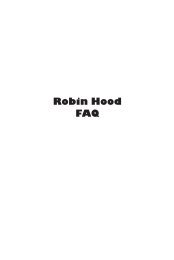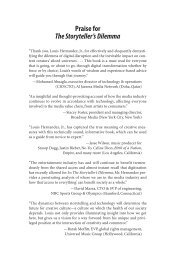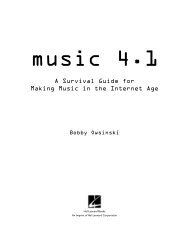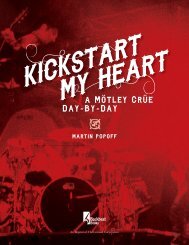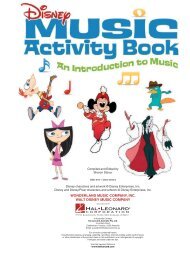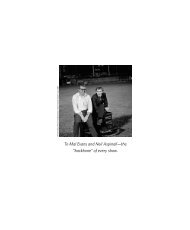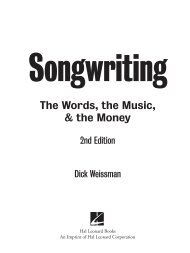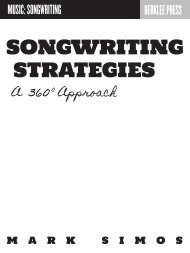You also want an ePaper? Increase the reach of your titles
YUMPU automatically turns print PDFs into web optimized ePapers that Google loves.
A <str<strong>on</strong>g>Hard</str<strong>on</strong>g> Day’s <str<strong>on</strong>g>Night</str<strong>on</strong>g><br />
Ray Mort<strong>on</strong><br />
LIMELIGHT<br />
EDITIONS<br />
An Imprint of Hal Le<strong>on</strong>ard corporati<strong>on</strong>
Copyright © 2011 by Ray Mort<strong>on</strong><br />
All rights reserved. No part of this book may be reproduced in any<br />
form, without written permissi<strong>on</strong>, except by a newspaper or magazine<br />
reviewer who wishes to quote brief passages in c<strong>on</strong>necti<strong>on</strong> with a review.<br />
Published in 2011 by Limelight Editi<strong>on</strong>s<br />
An Imprint of Hal Le<strong>on</strong>ard Corporati<strong>on</strong><br />
7777 West Bluemound Road<br />
Milwaukee, WI 53213<br />
Trade Book Divisi<strong>on</strong> Editorial Offices<br />
33 Plymouth St., M<strong>on</strong>tclair, NJ 07042<br />
Photo <strong>on</strong> page 5 of insert © United Artists, courtesy of Photofest. All<br />
other photos are from the pers<strong>on</strong>al collecti<strong>on</strong> of the author.<br />
Printed in the United States of America<br />
Book design by Mark Lerner<br />
Library of C<strong>on</strong>gress Cataloging-in-Publicati<strong>on</strong> Data<br />
Mort<strong>on</strong>, Ray, 1961-<br />
A hard day’s night / Ray Mort<strong>on</strong>.<br />
p. cm. -- (<str<strong>on</strong>g>Music</str<strong>on</strong>g> <strong>on</strong> film)<br />
Includes bibliographical references and index.<br />
ISBN 978-0-87910-388-0 (pbk.)<br />
1. <str<strong>on</strong>g>Hard</str<strong>on</strong>g> day’s night (Moti<strong>on</strong> picture) I. Title.<br />
PN1997.H2593M57 2011<br />
791.43’72--dc23<br />
2011026235<br />
www.limelightediti<strong>on</strong>s.com
To my brother Andrew,<br />
who loves movies and loves the Beatles
C<strong>on</strong>tents<br />
Introducti<strong>on</strong><br />
ix<br />
1. Meet the Beatles 2<br />
2. They’re G<strong>on</strong>na Put Me in the Movies 14<br />
3. It Took Me Weeks to Write 30<br />
4. Roll <strong>on</strong> Up 44<br />
5. A <str<strong>on</strong>g>Hard</str<strong>on</strong>g> M<strong>on</strong>th’s Shoot 56<br />
6. It W<strong>on</strong>’t Be L<strong>on</strong>g 96<br />
7. We Hope You Will Enjoy the Show 112<br />
Epilogue: And in the End 127<br />
<strong>Film</strong> Credits 129<br />
Soundtrack Albums 133<br />
Acknowledgments 139<br />
Bibliography 141<br />
Index 147
Introducti<strong>on</strong><br />
When the Beatles’ first feature film, A <str<strong>on</strong>g>Hard</str<strong>on</strong>g> Day’s <str<strong>on</strong>g>Night</str<strong>on</strong>g>,<br />
premiered <strong>on</strong> July 6, 1964, at the very height of Beatlemania,<br />
most people in and out of show business assumed it<br />
would be a big hit and make lots of m<strong>on</strong>ey, as everything<br />
associated with the Fab Four tended (and still tends) to do.<br />
However, few thought that it would actually be a good movie.<br />
There was no reas<strong>on</strong> to expect it to be: the picture was a<br />
low-budget, black-and-white quickie shot in six short weeks<br />
and rushed into release for the sole purpose of serving as an<br />
extended advertisement for an accompanying soundtrack<br />
album, which United Artists, the film’s distributor, hoped<br />
would earn its record divisi<strong>on</strong> a hefty profit before the Beatle<br />
craze fizzled out (as every<strong>on</strong>e, including the Beatles themselves,<br />
assumed it eventually would). As l<strong>on</strong>g as A <str<strong>on</strong>g>Hard</str<strong>on</strong>g><br />
Day’s <str<strong>on</strong>g>Night</str<strong>on</strong>g> featured enough close-ups of John, Paul, George,
x<br />
introducti<strong>on</strong><br />
and Ringo and showcased a sufficient number of s<strong>on</strong>gs, it<br />
didn’t have to be good. However, it was good—so good that<br />
it prompted critic Andrew Sarris to famously hail it as “the<br />
Citizen Kane of jukebox musicals”—and the movie’s reputati<strong>on</strong><br />
has c<strong>on</strong>tinued to grow in the five decades since its<br />
release, to the point where it is now c<strong>on</strong>sidered a b<strong>on</strong>a fide<br />
moti<strong>on</strong> picture classic.<br />
What makes A <str<strong>on</strong>g>Hard</str<strong>on</strong>g> Day’s <str<strong>on</strong>g>Night</str<strong>on</strong>g> such a memorable film?<br />
To begin with, it perfectly captures a moment in time—<br />
that strange, exciting period so l<strong>on</strong>g ago when the world<br />
went crazy for four charismatic lads from the north of England<br />
whose exhilarating music and vibrant pers<strong>on</strong>alities<br />
gave people who were still struggling to recover from war,<br />
scandal, and assassinati<strong>on</strong> something to feel good about.<br />
A <str<strong>on</strong>g>Hard</str<strong>on</strong>g> Day’s <str<strong>on</strong>g>Night</str<strong>on</strong>g> documented all the major touchst<strong>on</strong>es<br />
of Beatlemania: the adoring hordes that pursued the band<br />
members everywhere they went; the hysterical c<strong>on</strong>cert audiences<br />
whose screams drowned out the very s<strong>on</strong>gs they had<br />
ostensibly come to hear; the press c<strong>on</strong>ferences in which the<br />
Beatles bewitched and occasi<strong>on</strong>ally bemused the members of<br />
the fourth estate; the commercial establishment that sought<br />
to exploit the band’s appeal without really understanding<br />
it; and the harrumphing disgust of an older generati<strong>on</strong> that<br />
simply couldn’t fathom what all the fuss was about. It also<br />
captured the essence of the experience of the four young
Chapter 1
Meet the Beatles<br />
The greatest pop music band in history began life as a<br />
skiffle group called the Quarrymen in Woolt<strong>on</strong>, a middleclass<br />
suburb of Liverpool, England, in March 1957.<br />
Skiffle is a genre of music in which folk, jazz, and blues<br />
s<strong>on</strong>gs are played <strong>on</strong> cheap guitars, banjos, and homemade<br />
instruments such as washboards and basses fashi<strong>on</strong>ed<br />
from tea chests. In 1956, an English performer named<br />
L<strong>on</strong>nie D<strong>on</strong>egan released a skiffle versi<strong>on</strong> of the American<br />
folk tune “Rock Island Line.” It was a big hit and sparked<br />
a skiffle craze in the UK. Within a few short m<strong>on</strong>ths,<br />
thousands of amateur bands had popped up all around<br />
the country.<br />
Sixteen-year-old Woolt<strong>on</strong>ite John Lenn<strong>on</strong> got caught<br />
up in the excitement. Already a fan of Elvis and rock ’n’
4<br />
a hard day’s night<br />
roll, John persuaded Mimi Smith, his aunt and guardian,<br />
to buy him a guitar and then recruited classmates from<br />
the Quarry Bank Grammar School to join him in a group<br />
named after their school. Playing covers of established hits,<br />
the Quarrymen performed in a number of skiffle c<strong>on</strong>tests<br />
and at parties, cinemas, and school dances. In July 1957, Ivan<br />
Vaughn, the Quarrymen’s sometime bass player, invited his<br />
friend Paul McCartney to come see the group play at a village<br />
fête. Like John, the fifteen-year-old Paul had been inspired<br />
by L<strong>on</strong>nie D<strong>on</strong>egan to learn to play the guitar (left-handed).<br />
Impressed by Paul’s talent, John asked him to join the band.<br />
Inspired by singer/s<strong>on</strong>gwriter Buddy Holly, John and Paul<br />
began writing their own s<strong>on</strong>gs, both separately and together,<br />
which were then incorporated into the band’s repertoire.<br />
By the fall of 1957, the skiffle craze had faded. Many of<br />
the recently formed groups disbanded, but some, like the<br />
Quarrymen, carried <strong>on</strong> by fusing skiffle with rock ’n’ roll,<br />
doo-wop, R&B, and soul into a unique new guitar-anddrum-dominated<br />
genre called Beat <str<strong>on</strong>g>Music</str<strong>on</strong>g> (a.k.a. British<br />
Beat or, in Liverpool, Merseybeat, after the Mersey River<br />
that flowed through the heart of the city).<br />
Busy with work, school, and life, many of the Quarrymen’s<br />
founding members began dropping out of the band. To<br />
replace them, Paul recruited a fourteen-year-old schoolmate<br />
named George Harris<strong>on</strong>. Harris<strong>on</strong>, who had taught himself
Chapter 4
Roll <strong>on</strong> Up<br />
As the script was taking shape, Richard Lester and Walter<br />
Shens<strong>on</strong> began assembling the filmmaking team that<br />
would help them bring The Beatles to life.<br />
To handle the practical, nuts-and-bolts aspects of the<br />
producti<strong>on</strong>—preparing budgets and schedules, ordering<br />
equipment, securing filming locati<strong>on</strong>s, and hiring crews—<br />
Denis O’Dell was brought in to serve as the movie’s associate<br />
producer. An experienced assistant director and<br />
line producer, O’Dell had just returned to England from<br />
a l<strong>on</strong>g stay in Yugoslavia, where he had supervised the<br />
shooting of the Richard Widmark/Sidney Poitier Viking<br />
epic The L<strong>on</strong>g Ships, when he received a call from Bud Ornstein<br />
asking him to join The Beatles. Exhausted, O’Dell<br />
declined, but when his teenage children discovered that he
46<br />
a hard day’s night<br />
had turned down a chance to work with their favorite band,<br />
they badgered him into calling Ornstein back and accepting.<br />
One of O’Dell’s first tasks was to establish a producti<strong>on</strong><br />
base for the film at Twickenham <strong>Film</strong> Studios. Located in<br />
the L<strong>on</strong>d<strong>on</strong> suburb of St. Margarets, the facility would house<br />
the movie’s sets and offices; costume, makeup, and prop<br />
workshops; and editing rooms.<br />
Since The Beatles was c<strong>on</strong>ceived as a ficti<strong>on</strong>al documentary,<br />
Lester decided that he wanted the film to look like a<br />
real documentary—he felt this would greatly enhance the<br />
movie’s reality and believability. Adopting the techniques<br />
of the French New Wave filmmakers he so admired, Lester<br />
planned to shoot the black-and-white producti<strong>on</strong> (the budget<br />
was too low to afford color film) <strong>on</strong> as many real locati<strong>on</strong>s<br />
as possible, using an informal visual style that incorporated<br />
a good deal of handheld camera work, liberal use of zoom<br />
lenses, and as much natural lighting as possible. For this<br />
reas<strong>on</strong>, he recruited veteran British cinematographer Gilbert<br />
Taylor (Dr. Strangelove or: How I Learned to Stop Worrying<br />
and Love the Bomb). Taylor had photographed It’s Trad, Dad<br />
for Lester in a similar fashi<strong>on</strong> and the director wanted him<br />
to push the c<strong>on</strong>cept further in their new film.<br />
John Jymps<strong>on</strong>, acclaimed for his stellar work <strong>on</strong> Zulu, was<br />
engaged to edit the picture and Ray Simm (Billy Liar) signed<br />
<strong>on</strong> as art director. The Beatles was scheduled to be shot <strong>on</strong> a
Chapter 5
A <str<strong>on</strong>g>Hard</str<strong>on</strong>g> M<strong>on</strong>th’s Shoot<br />
The Beatles began filming <strong>on</strong> M<strong>on</strong>day, March 2, 1964.<br />
As the cameras rolled, Richard Lester had <strong>on</strong>e primary<br />
goal: to capture the spirit of the Beatles <strong>on</strong> celluloid as<br />
accurately as possible. “I had a marvelous image in fr<strong>on</strong>t<br />
of me to reflect and that was . . . their energy and their<br />
originality. So, you know, all [I] did was to say . . . ‘How<br />
can I, as a filmmaker, best serve what I find so attractive<br />
in these four people?’”<br />
He began by creating a relaxed atmosphere in which<br />
the novice actors would feel comfortable: “I worked to<br />
make it as light as possible, so that you were not really<br />
aware that this was anything serious or important going<br />
<strong>on</strong>. Just keep it <strong>on</strong> a terribly easy level.”
58<br />
a hard day’s night<br />
Lester generally kept the camera loose, so the Beatles<br />
wouldn’t have to worry about hitting precise marks. If <strong>on</strong>e<br />
of the boys flubbed a line, the director wouldn’t fuss; instead,<br />
he just kept shooting and had them repeat the dialogue that<br />
had g<strong>on</strong>e awry. If that didn’t work, he would simply give<br />
them an entirely new line to say.<br />
During the first week of filming, Lester realized that the<br />
Beatles never played a scene the same way twice, which<br />
wreaked havoc with the film’s c<strong>on</strong>tinuity. To rectify this, he<br />
began using two cameras to film every scene, which allowed<br />
him to photograph the close-ups and wide angles simultaneously<br />
so that the boys wouldn’t have to worry about<br />
matching their acti<strong>on</strong>s precisely from shot to shot. Lester<br />
was so happy with the results that this became his standard<br />
way of working <strong>on</strong> all his films from then <strong>on</strong>. He would occasi<strong>on</strong>ally<br />
film rehearsals without telling the lads that the<br />
cameras were running in order to capture a more laid-back,<br />
unguarded performance.<br />
Worried that the Beatles would become self-c<strong>on</strong>scious<br />
if they saw themselves <strong>on</strong>screen, Lester didn’t want them to<br />
watch the rushes, so he would screen them in secret during<br />
his lunch breaks. The Beatles began to w<strong>on</strong>der where their<br />
director was sneaking off to, and <strong>on</strong>e day they followed him<br />
and barged in <strong>on</strong> the screening. From then <strong>on</strong>, they joined<br />
Lester almost every day.
A <str<strong>on</strong>g>Hard</str<strong>on</strong>g> M<strong>on</strong>th’s Shoot 59<br />
While no <strong>on</strong>e would ever accuse the Beatles of being<br />
master thespians, Lester’s approach gave the lads the room to<br />
blossom into captivating screen pers<strong>on</strong>alities. When Walter<br />
Shens<strong>on</strong>’s wife asked him after the first day of filming if the<br />
Beatles could act, he said, “I d<strong>on</strong>’t know. But I do know you<br />
can’t take your eyes off them.”<br />
Lester directed the rest of the film in the same loose manner,<br />
leaving plenty of room for sp<strong>on</strong>taneity and <strong>on</strong>-the-spot<br />
inventi<strong>on</strong>. If a member of the cast or crew came up with an<br />
ad lib that Lester liked, he’d use it. If something interesting<br />
happened <strong>on</strong> the set, he would find a way to work it into<br />
the scene. If mistakes were made or problems arose, Lester<br />
would maneuver around them or else incorporate them<br />
into the picture. He reworked scenes and sequences <strong>on</strong> the<br />
spot to make them more effective and frequently tossed in<br />
new, unscripted gags at the last minute. In keeping with his<br />
absurdist sense of humor, some of these gags were surreal in<br />
nature. Although they seemed inc<strong>on</strong>gruous with the realistic<br />
approach that he had dictated for the picture, Lester wasn’t<br />
bothered by the apparent discrepancy; for him, the documentary<br />
style was a jumping-off point for the film rather<br />
than a formal end in itself. Lester felt the absurd gags were<br />
justified because they kept the piece fresh and, since this<br />
was the sort of humor that the Beatles enjoyed, accurately<br />
reflected the band’s sensibility.





